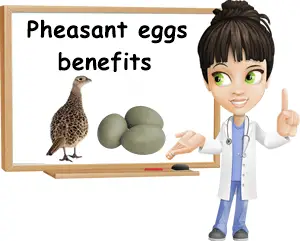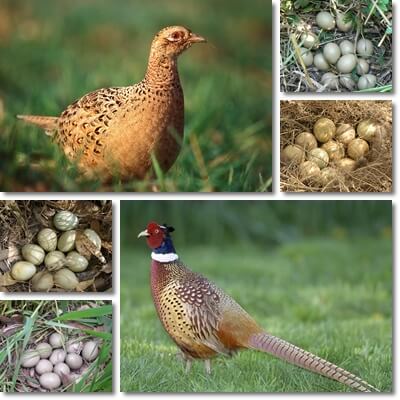Pheasants are heavy-bodied birds in the Phasianidae family and are related to chicken, quail, peafowl, partridges and turkey. Originally from Asia, they have been successfully introduced almost everywhere in the world and have developed sustainable feral populations in many regions. Pheasant farms also exist in many parts of the world and their primary purpose is to meet the commercial demands for the bird without effecting negative changes in wild populations.
Pheasant farms may also support feral populations by releasing birds into the wild when their numbers are in decline or when populations are being threatened with extinction for various reasons. Both the gamy meat and eggs are edible and safe for human consumption. Out of the several dozen different species and subspecies of pheasants, the most widely spread and known is the common pheasant (Phasianus colchicus). The species has become naturalized in Europe, North America, Australia and can be found throughout Asia.

What do pheasants look like?
This particular bird has many subspecies, but generally looks a lot like a chicken-peafowl hybrid. The male can weigh up to 3 kg, has a metallic, dark green head, small crest and bright red wattle, a white ring at the base of the neck followed by gold, red-copper and different shades of brown body plumage with white on the wings and sometimes iridescent blue, green or purple and either a brown or black, long tail. The pheasant hen is usually less than 1 kg and has dull brown plumage with dark-brown or black markings (bars, spots) and a shorter tail. While coloration patterns in the males may vary greatly, the hens are usually mostly brown.
Can you eat pheasant eggs?
Pheasant eggs are perfectly good for eating, just like any other edible egg variety. Pheasant eggs are not just edible, but also good for you. Pheasant eggs are good to eat for their nutritional value, notably protein content, fat content and content of essential vitamins and dietary minerals. In fact, eating pheasant eggs is as safe as eating chicken eggs, and the eggs provide a nutrition similar to that of chicken.
How many eggs does a pheasant hen lay?
Common pheasants lay 8-12 eggs from April or May to June. Some hens may lay up to 18 eggs and start nesting at around 18 weeks. Smaller species may lay only 1 egg. The eggs are not laid in one day, but over the course of several days. After the clutch is complete, the hens proceed to incubate the eggs. Pheasant eggs incubation lasts around 22-23 days and up to 25 days in the wild.

What do pheasant eggs look like?
Pheasant eggs have a typical ovoid shape, rounder at one end and significantly more pointed at the other end, similar in appearance to guinea fowl eggs.
They are visibly smaller than chicken eggs. Typically, common pheasant eggs are a pale olive color, with or without spots. Eggshell color may also include brown like chicken eggs or light brown, darker gray and pale blue-green.
Pheasant eggs size
On average, one common pheasant egg weighs between 30.4 g and 33.4 g, less than a small chicken egg (with an estimated weigh of 38 g). Eggs that weigh between 27.8-29.7 g are classified as light; eggs that weigh between 29.8-31.7 g are medium, while eggs that weight between 31.8-33.7 g are heavy.
What do pheasant eggs taste like?
Eggs from wild pheasants or pheasants on a diet as close as possible to their natural one will have a bit of a gamy taste to them. Because of the larger egg yolk, they also usually taste creamier and slightly richer, but are not very heavy.
If the eggs come from your own backyard or from a local farmer, chances are they will taste very similar to chicken eggs, except a little creamier from the larger yolk. The reason for the similar taste of farmed pheasant eggs and chicken eggs is the birds’ diet which is in most cases almost identical. Pheasants in the wild normally eat seeds and grains of all kinds, fruit like berries, leaves, insects like grasshoppers, spiders, caterpillars, ants and ant eggs, even small lizards, fish or mammals.
Should pheasant eggs be washed?
If the eggs are particularly dirty (soil and other matter), they are best washed and dried with a paper towel before breaking the shell open. This helps to make sure any bacteria that may have been on the shell does not end up on your plate. If the eggs are cooked thoroughly (through hard boiling, soft boiling, scrambling or incorporated into foods that are fried, baked or boiled), the risks of getting sick are almost nonexistent. In any case, get your pheasant eggs from certified produces or
Are pheasant eggs good to eat?
Yes, they are. Pheasant eggs are both edible and nutritious, providing roughly the same micro and macronutrient values as all other egg varieties. Like all eggs, pheasant too supply important amounts of protein with all essential amino acids, fats and cholesterol, B vitamins, vitamin D and dietary minerals like iron, phosphorus, potassium, magnesium, calcium and zinc.
How are pheasant eggs good for you?
Pheasant eggs provide benefits for brain and nervous system health, immune system, energy metabolism, bones, skin, hair and muscles. Their varied nutritional profile is a source of multiple benefits that contribute to both physical and mental health.
What are the benefits of pheasant eggs?
While little is known about the nutritional properties of this egg variety, it should be noted that, as eggs of a chicken-related bird species, they provide a nutrition similar to that of chicken. Eggs from farmed pheasants have even stronger nutritional similarities to chicken because of their similar diets. As such, pheasant eggs provide the following nutrition and health benefits:
Source of quality protein
Eggs in general are good sources of protein, pheasant included, and provide all essential amino acids the body requires to keep us healthy, but cannot synthesize itself. Protein is especially good building and repairing muscle tissue and provides satiety, with possible benefits for weight loss. The amino acids that make up protein are used by the brain to synthesize neurotransmitters that regulate mood, appetite, sleep etc.
Good fat content and profile
Pheasant eggs contain unsaturated, saturated fat and cholesterol and provide an overall significant fat intake if consumed regularly. It should be noted this particular variety has more egg yolk compared to chicken eggs for example, which means more fat content. Fat is important as food for the brain, helping reduce brain fog and support intellectual effort as well as contributes to better hair and skin appearance. It is also the basis for the absorption of fat soluble vitamins like vitamins A, D, E and K and carotenoid antioxidants.
Contain cholesterol, saturated fat and Omega-3
The egg yolk is a source of cholesterol which helps keep the brain and nervous system working optimally. Cholesterol is actually physically present in the brain and makes up the protective coating surrounding the tail of our nerve cells. It is believed it play an important role in preventing nervous system degeneration. A sufficient intake of dietary cholesterol from pheasant and other eggs also helps synthesize vitamin D for better immunity and endocrine health. Saturated fats produce no ill effects when consumed in limited amounts, while Omega-3, assumed to be present in the eggs of birds that enjoy a natural diet, helps the brain and nervous system develop in babies in the womb.
Moderate to low calorie content, no fiber
Pheasant eggs are expected to provide a moderately low calorie intake and, like all other animal products, contain no fiber. Soft boiled or poached pheasant eggs can be consumed occasionally by those with gastrointestinal conditions that require a limited intake of dietary fiber, such as gastritis.
More on the nutritional value of pheasant eggs
Pheasant eggs have a good nutritional value and provide good amounts of B vitamins, especially vitamins B9 and B12, choline, vitamin D, and trace amounts of vitamins A and E, calcium, iron, magnesium, phosphorus, potassium, selenium, sodium and zinc (nutrients present in all types of eggs).
B vitamins in pheasant eggs contribute to energy metabolism and, together with iron, help combat fatigue. Choline from pheasant eggs is good for memory and supports cognitive functions such as learning. Vitamins D, A and zinc in pheasant eggs strengthen the immune system and boost fertility, while vitamin D, calcium and phosphorus support bone health.
Pheasant eggs vs chicken eggs
There is little known about the nutrition of pheasant eggs, but overall they are considered very similar to chicken eggs, especially if the birds enjoy similar diets. One major difference between the two egg varieties is to be noted: pheasant eggs have more yolk which means more vitamins overall, more fat and possibly more calories than chicken eggs. Eggs from birds from the wild are theorized to be good sources of choline, Omega-3 fatty acids and possibly vitamins A and D.
How to incubate pheasant eggs
Choose clean eggs with a healthy shape and of good size (discard dirty eggs with unusual shapes and light weight eggs). It’s best the eggs are the same color so you know they come from the same type of bird and have similar incubation requirements. It is recommended to incubate pheasant eggs at 99.4 degrees Fahrenheit, at about 53% relative humidity from day 1 to day 20. The eggs need to be turned daily.
From day 21 to day 23 or 25, recommended temperature is 98 degrees Fahrenheit and the humidity 53%. This is the hatching period and the eggs no longer require turning. When some chicks are hatched and most eggshells broken, which should be sometime after day 23, you can increase humidity to make it easier for the chicks to get out of the eggshells. Depending on the pheasant species and type of incubator or hatcher, different incubation requirements may apply, so do some research beforehand.
Pheasant eggs are best incubated within 11 days, turned daily and checked for viability before incubation. If you buy pheasant eggs for hatching, it might be best to get them from an experienced local farmer and check if the eggs are viable before placing them in an incubator. This is done by candling: hold the egg before a bright light, preferably LED to see if there is an air sack and the eggs are good to incubate.
Candling should be repeated sometime into the incubation process (around day 7 or 10) to monitor chicks development inside the eggs (blood vessels forming and movement are good signs; clear egg, no blood vessels, no movement means the eggs will not hatch). There are also pheasant eggs for sale online, but make sure you check specifications (eggs may be destined for human consumption or incubation). Also know that pheasant eggs are often difficult to hatch, with sometimes only 50% rates of success.
